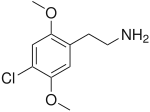2C-C
2C-C is a psychedelic drug of the 2C family. It was first synthesized by Alexander Shulgin, sometimes used as an entheogen. In his book PiHKAL (Phenethylamines i Have Known And Loved), Shulgin lists the dosage range as 20–40 mg. 2C-C is usually taken orally, but may also be insufflated.[1] 2C-C is schedule I of section 202(c) of the Controlled Substances Act in the United States, signed into law as of July, 2012 under the Food and Drug Administration Safety and Innovation Act.[2]
 | |||
| |||
| Names | |||
|---|---|---|---|
| Preferred IUPAC name
2-(4-Chloro-2,5-dimethoxyphenyl)ethan-1-amine | |||
| Other names
(4-Chloro-2,5-dimethoxyphenethyl)amine | |||
| Identifiers | |||
3D model (JSmol) |
|||
| ChEMBL | |||
| ChemSpider | |||
PubChem CID |
|||
| UNII | |||
CompTox Dashboard (EPA) |
|||
| |||
| |||
| Properties | |||
| C10H14ClNO2 | |||
| Molar mass | 215.6778 g/mol | ||
| Melting point | 220 to 221 °C (428 to 430 °F; 493 to 494 K) (hydrochloride) | ||
Except where otherwise noted, data are given for materials in their standard state (at 25 °C [77 °F], 100 kPa). | |||
| Infobox references | |||
Not much information is known about the toxicity of 2C-C.
Effects
Over the approximate dose range 20–40 mg, visual effects last approximately 4 to 8 hours.[1]
Drug prohibition laws
China
As of October 2015 2C-C is a controlled substance in China.[3]
Canada
As of October 31, 2016; 2C-C is a controlled substance (Schedule III) in Canada. http://gazette.gc.ca/rp-pr/p2/2016/2016-05-04/html/sor-dors72-eng.php
Germany
2C-C is an Anlage I controlled drug.
Sweden
Sveriges riksdags health ministry Statens folkhälsoinstitut classified 2C-C as "health hazard" under the act Lagen om förbud mot vissa hälsofarliga varor (translated Act on the Prohibition of Certain Goods Dangerous to Health) as of Mar 1, 2005, in their regulation SFS 2005:26 listed as 2,5-dimetoxi-4-klorfenetylamin (2C-C), making it illegal to sell or possess.[4]
United States
As of July 9, 2012, in the United States 2C-C is a Schedule I substance under the Food and Drug Administration Safety and Innovation Act of 2012, making possession, distribution and manufacture illegal.[5]
Analogues and derivatives
Analogues and derivatives of 2C-C:
25C-NB*:
- 25C-NBF
- 25C-NBMD
- 25C-NBOH
- 25C-NBOMe (NBOMe-2CC)
- 25C-NB3OMe
- 25C-NB4OMe
See also
References
- Shulgin, Alexander; Shulgin, Ann (September 1991). PiHKAL: A Chemical Love Story. Berkeley, California: Transform Press. ISBN 0-9630096-0-5. OCLC 25627628.
- "S. 3187: Food and Drug Administration Safety and Innovation Act, Subtitle D-Synthetic Drugs". FDA. June 27, 2012. Archived from the original on July 4, 2012. Retrieved July 12, 2012.
- "关于印发《非药用类麻醉药品和精神药品列管办法》的通知" (in Chinese). China Food and Drug Administration. 27 September 2015. Archived from the original on 1 October 2015. Retrieved 1 October 2015.
- "20050026" (PDF). Archived (PDF) from the original on 2013-09-29. Retrieved 2017-03-24.
- "Erowid 2C-C Vault : Legal Status". www.erowid.org. Archived from the original on 2014-06-02.

